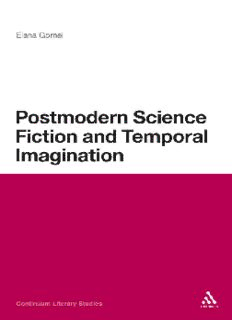
Postmodern science fiction and temporal imagination PDF
Preview Postmodern science fiction and temporal imagination
Postmodern Science Fiction and Temporal Imagination Also available from Continuum Measureless Time of Joyce, Deleuze and Derrida, Ruben Borg Palimpsest: Literature, Criticism, Theory, Sarah Dillon Postmodern Science Fiction and Temporal Imagination Elana Gomel Continuum Literary Studies Continuum International Publishing Group The Tower Building 80 Maiden Lane 11 York Road Suite 704 London SE1 7NX New York, NY 10038 www.continuumbooks.com © Elana Gomel 2010 All rights reserved. No part of this publication may be reproduced or transmitted in any form or by any means, electronic or mechanical, including photocopying, recording, or any information storage or retrieval system, without prior permission in writing from the publishers. Elana Gomel has asserted her right under the Copyright, Designs and Patents Act, 1988, to be identifi ed as Author of this work. British Library Cataloguing-in-Publication Data A catalogue record for this book is available from the British Library. ISBN: 9781441123954 (hardcover) Library of Congress Cataloging-in-Publication Data Gomel, Elana. Postmodern science fi ction and temporal imagination / Elana Gomel. p. cm. -- (Continuum literary studies) Includes bibliographical references. ISBN 978-1-4411-2395-4 1. Science fi ction--History and criticism. 2. Time in literature. 3. Postmodernism (Literature) I. Title. II. Series. PN3433.5.G66 2010 809.3'8762--dc22 2009050601 Typeset by Newgen Imaging Systems Pvt Ltd, Chennai, India Printed and bound in Great Britain by MPG Books Group Ltd This one is for Jim It seems to me, then, that time is merely an extension, though of what it is an extension I do not know. I begin to wonder whether it is an extension of the mind itself. St Augustine, Confessions Contents Acknowledgements viii Preface: Timeshapes ix Introduction: Time Enough for World 1 Chapter 1 T he Time Machines: H. G. Wells and the Invention of Postmodernity 27 Chapter 2 S trangled by the Time Loop: Paradoxes of Determinism 53 Chapter 3 ‘ My Name is Might-Have-Been’: Contingency, Counterfactuals and Moral Choice 82 Chapter 4 E veryday Apocalypse: The Ethics and Aesthetics of the End of Time 118 Conclusion: Beyond Millennium 147 Notes 162 Works Cited 165 Index 175 Acknowledgements This book would not have been possible without the support, encouragement and intellectual input of many people. Special thanks are due to my colleagues and friends at the Department of English and American Studies of Tel-Aviv University. Dr Amit Yahav of Haifa University fi rst drew my attention to the problematic of temporality. My editors at Continuum made this book possible by setting fi rm deadlines. My mother Maya Kaganskaya and my sons Ariel and Eliran Gomel were as inspirational as ever. My students in the courses of Science Fiction, Fantasy and Postmodernism were invaluable in responding with genu- ine enthusiasm to the ideas expressed in this book and offering insights of their own. I thank all of them, particularly Hadass Elber and Shawn Edrei. And fi nally, my profoundest gratitude goes to Dr Jim Martin. This book is for him. Preface: Timeshapes O Attic shape! Fair attitude! with brede Of marble men and maidens overwrought, With forest branches and the trodden weed; Thou, silent form, dost tease us out of thought As doth eternity. This is John Keats’ ‘Ode on a Grecian Urn’ (1819). In the poem, time congeals into a material shape, permanent and palpable; the present becomes charged with eternity; and the fl ux of beginning, middle and end freezes into the perpetual ‘now’. In ‘Theses on the Philosophy of History’ (1940) Walter Benjamin writes: ‘A historical materialist cannot do without the notion of a present which is not a transition, but in which time stands still and has come to a stop’ (Benjamin 262). Historical fl ux becomes an object to be examined and evaluated. In Alastair Reynolds’ science fi ction novel Century Rain (2004) a ‘quantum snapshot’ of Earth in 1940 is enclosed in a giant cosmic sphere, complete with all the people who existed at that point in time, as immobile and eternal as Keats’ painted maiden. ‘Jolted’ back into time, it begins to develop, acquitting its own history. But are people in it any more real than ‘the images in a burning photograph’ (Reynolds 284)? Do they feel anything? Is their transition back into time a deliverance or a fall? A masterpiece of poetry; a longing for a new kind of history and a new kind of historian; a science fi ction novel. As motley a collection of texts as one could assemble. And yet they share something: an image of time, which is tangible and material and yet paradoxical and elusive; time as an object in space; time as a shape. It is not merely that all three texts wish time would stand still, as one often wishes when faced with a beautiful moment or a looming deadline. They intimate that time is already standing still; has always been standing still; that our perception of the evanescence of the present and the non-existence of the past and the future is an illusion. Eternity is real; time is not. Whether this eternity is conceived as the world of Platonic ideas as in Keats; the Marxist pattern of history as in Benjamin; or a physical property of the quantum universe as in Reynolds can, for now, be set aside. What is important for my
Description: